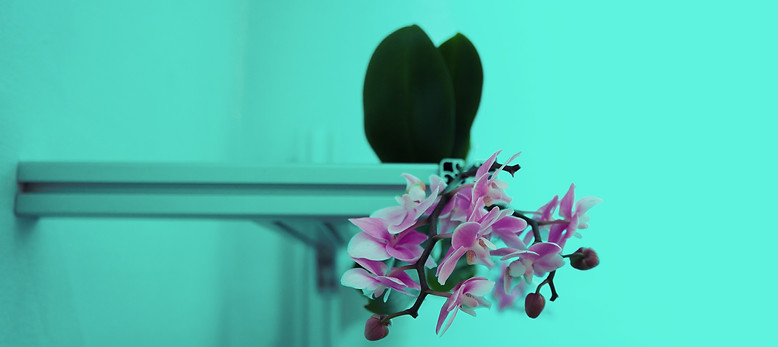

HTLAL?
EXHIBITION 02
"Overlap"
Kommer &
Frickhœffer
Studio45 Gallery
Feb. 2024, Hamburg
a Kaeur Studio research-project
CURATING
"Overlap"
supported by the Ministry of Culture and Media of the Free and Hanseatic City of Hamburg
by Kommer & Frickhœffer
curated by HTLAL?
Landscapes are structures – complex parts of our cultural systems, they hold memories, meanings, and they are not untouched by change. The presented body of work combines modular structures with living flora, a dialogue between the biological system of plant material and seemingly lifeless systems like aluminum. Natural and artificial is not oppositional, it's dialectical.
Both presented material matters are systems, they follow a logic and interact with space. “A system is a group of interacting or interrelated elements that act according to a set of rules to form a unified whole.” (Merriam-Webster) A system, situated in a space, can be defined by its boundaries, structure and purpose, and is expressed in its functioning and self-preservation.
The aluminum modules are structure originally developed to design workplaces and production facility lines. Systemic means in this sense that each part is constructed under certain parameters like size and form to interact specifically with the other parts. Intrinsically their purpose is to give space to a secondary system.
This secondary system which initially would hold the means of production gets replaces by plants – flowers. Both realms of objects now share the same place, they interact, they overlap. This happens in a way of an afterthought; the modules were never meant to hold plants and the plants were not cultivated for this purpose either.
 |  |  |
|---|---|---|
 |  |  |
A Methodology in progress
Orchids
There are ca. 30.000 different orchid species. And while some of them are used and cultivated in the production of vanilla – a tedious act which requires to pollinate the plant by hand – are most orchid species solemnly grown for aesthetic purposes. This led to the common understanding of the orchid as a luxury decorative plants.
It´s cultural meaning and significance is inter/trans-cultural – and can be found for example in indigenous South American cultures, Ancient Greek and the Chinese Quin dynasty.
Most tropical orchids are so-called epiphytes (, which means that they grow on other plants. In the treetops of the tropical rainforest, they get exactly the amount of sun and shade they need. Some of the roots cling to branches and twigs, while others reach up into the air.
They are nourished by what is deposited on the branches from decaying plant parts and what the rain and high humidity bring in. Orchids are therefore extremely frugal. In addition to the orchids that live as epiphytes on trees, there are also species that are native to the ground, a few even on rocks.
The evolutionary history of the orchid is not yet complete. Even today, it is still producing new forms and colors, so-called natural hybrids.
Like its hybridity its semiotic meaning in literature and visual art is ever evolving with a rich history of reference points and motif tradition.
Tillandsia
Tillandsias belong to the bromeliad family and originally come from forests, deserts and mountainous regions in Central and South America, Mexico and the southern United States. The plant probably developed in the Cretaceous period around 65 million years ago. Fossilized specimens have been dated to an age of up to 30 million years, which is why the plant can rightly be described as a prehistoric plant.
The plant was cultivated first by Incas, Aztecs and Mayas as a food source and for cultural/spiritual purpose.
Tillandsias don´t depend on soil or being watered – they extract their needed resources from the air of the space they inhabit. This means that they make use of a third, invisible system.
Alluminium
Aluminum ranks as the third most abundant element in the Earth's crust. Extracted from bauxite, primarily mined in tropical and subtropical regions like Australia, Guinea and Brazil, additional deposits are found in India, North China, Russia, and Suriname.
The extraction of 1 kg of aluminum from bauxite requires approximately 15 to 20 kilowatt-hours (kWh) of energy. Bauxite is crushed, dispersed in a solution, and transformed through electrolysis into aluminum oxide and metallic aluminum.
Bauxite mining involves significant interventions in our landscape, environment, and ecosystems. Evident impacts include deforestation leading to biodiversity loss, soil destruction causing erosion and damage to fertility. High water consumption, compromised water quality, and arid air due to sediments can follow, along with social consequences affecting local communities.
Recycled aluminum conserves up to 95% of energy and, depending on transportation, reduces carbon dioxide emissions by up to 90% compared to primary production. About 75% of all produced aluminum remains in the production cycle.
Mining, processing, production, impact, and consequences collectively influence our ecosystem, forming overlapping systems which cannot be viewed in isolation.
Sebastian Kommer is an industrial designer who is working on modular systems and the interplay of natural and industrial material. His furniture-centered practise is exhibited and sold internationally. He is currently teaching at the Muthesius University of Fine Arts and Design where he received his Bachelor before gaining his Masters in the Open Design Class of Konstantin Grcic in 2023 (HFBK).
https://sebastiankommer.com/
Matthis Frickhœffer leads Kaeur Studio´s research-project "How to look at landscapes?". They are a conceptual artist and researcher.
